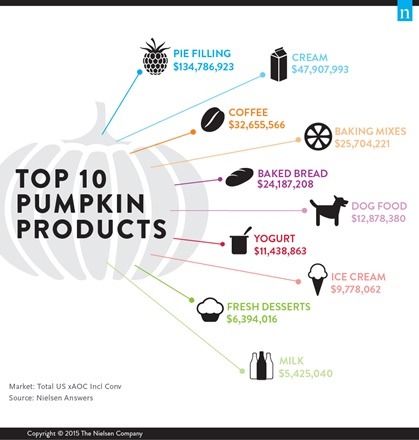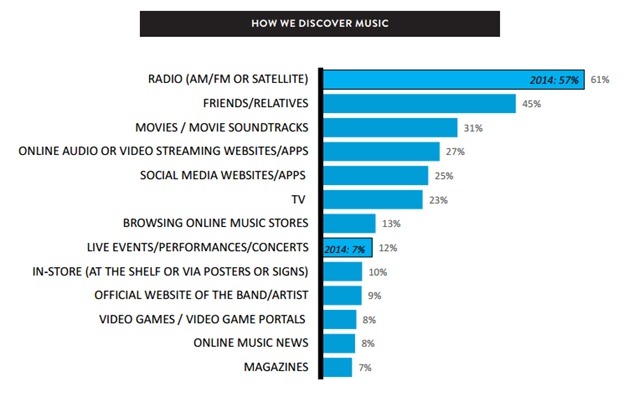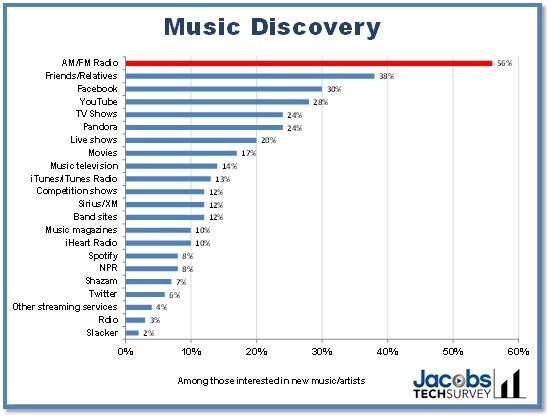I always look forward to Nielsen’s data releases, especially about audience dimensions that go beyond the ratings. Their reports on streaming, mobile, and other key dimensions are often revealing and helpful for those of us actively positioning and marketing radio in a fast-moving media environment. And their newly released Total Audience Report is a great service to the industry, helping all of us in media “keep score.”
That said, not all their data is incisive or even that useful. I couldn’t help but notice a recent release about the top 10 pumpkin products. With Halloween fast approaching, this seems timely, but somehow not germane to what most of us are thinking about as we zoom into Q4.
Still, the dog food finding is a bit of an outlier.
But to get to the main point of this post, Nielsen recently released some very important data about how Americans discover music. That continues to be a major topic in radio circles, especially for formats like Alternative and Triple A. And as their analysis concludes, radio continues to be the top source for music discovery, ahead of friends and relatives. This level for radio is four points higher than 2014 levels as the chart shows:
But before you start ordering party favors and cranking out sales pieces, take a closer look at the data. “Radio” is defined as “AM/FM or satellite.” Yes, that means that SiriusXM is included in the “radio” calculation. So it’s great to be #1, but for broadcasters, it’s not a clean win.
So to perhaps better illuminate the situation, here’s a look at a very similar question in this year’s Techsurvey11. Now keep in mind that our 46,000+ respondents are mostly derived from radio station email databases. So there’s that. But we separate broadcast radio from satellite, while also offering many more choices. Here’re our results:
Our survey shows AM/FM at the top of the chart, although at a somewhat lower level than in the Nielsen report. Note also that Sirius/XM is well down the list. We also included a number of other brands, from Pandora to Spotify to NPR.
The broadcast radio industry proudly holds onto the “R-word,” not willing to relinquish it to the SiriusXM folks (or anyone else). It needs to stand up on its own.
In the meantime, a cup of pumpkin-flavored coffee sounds pretty good right now.
- What To Do If Your Radio Station Goes Through A Midlife Crisis - April 25, 2025
- A 2020 Lesson?It Could All Be Gone In A Flash - April 24, 2025
- How AI Can Give Radio Personalities More…PERSONALITY - April 23, 2025







Great Chart! BTW the original Schmielsen (as in Harry) featured “You’re Breaking My Heart so….whoo hooo.” Our WBZ AM/FM special edit by “The Famous” Jim Sands, circa 1972. Clark http://www.broadcastideas.com See you in Atlanta.
We all miss Harry. Thanks, Clark.
For the record, I just changed the name of my fantasy football team to “Nielsen Schmielsen” 🙂
I hope it leads to a winning season, but it will most certainly make your team stand out.
As someone who interprets and reports Nielsen audience numbers to clients and is constantly asked the question, “but what do these numbers MEAN,” I’m interested in some of the finer points of your info-gathering. What, for example, is the difference between hearing about new music from Facebook/Twitter, hearing about new music from family & friends and hearing about new music from family & friends via Facebook/Twitter?
And, god forbid, if I heard the new Jess Glynne song from a Spotify list that my friend posted on Facebook, (which happened today) then how would I have answered that question on your survey?
ps made a batch of coconut M&M cookies with a dash of lime in the batter once, called them Schmillsons. Weren’t all bad.
Erin, you make a great point that discovery can be a multi-layered experience. That’s why we allow respondents to select multiple sources – like Facebook, AM/FM radio, and my cousin Tina. My beef with the Nielsen survey is that those choices need to be clear and distinct. And when “radio” becomes a catch-all for terrestrial and satellite, something is very lost in translation. While you might expect that foggy labeling from a research company that doesn’t not specialize in media, Nielsen knows better.
Thanks for taking the time to comment, and I hope those yummy-sounding cookies tasted great.